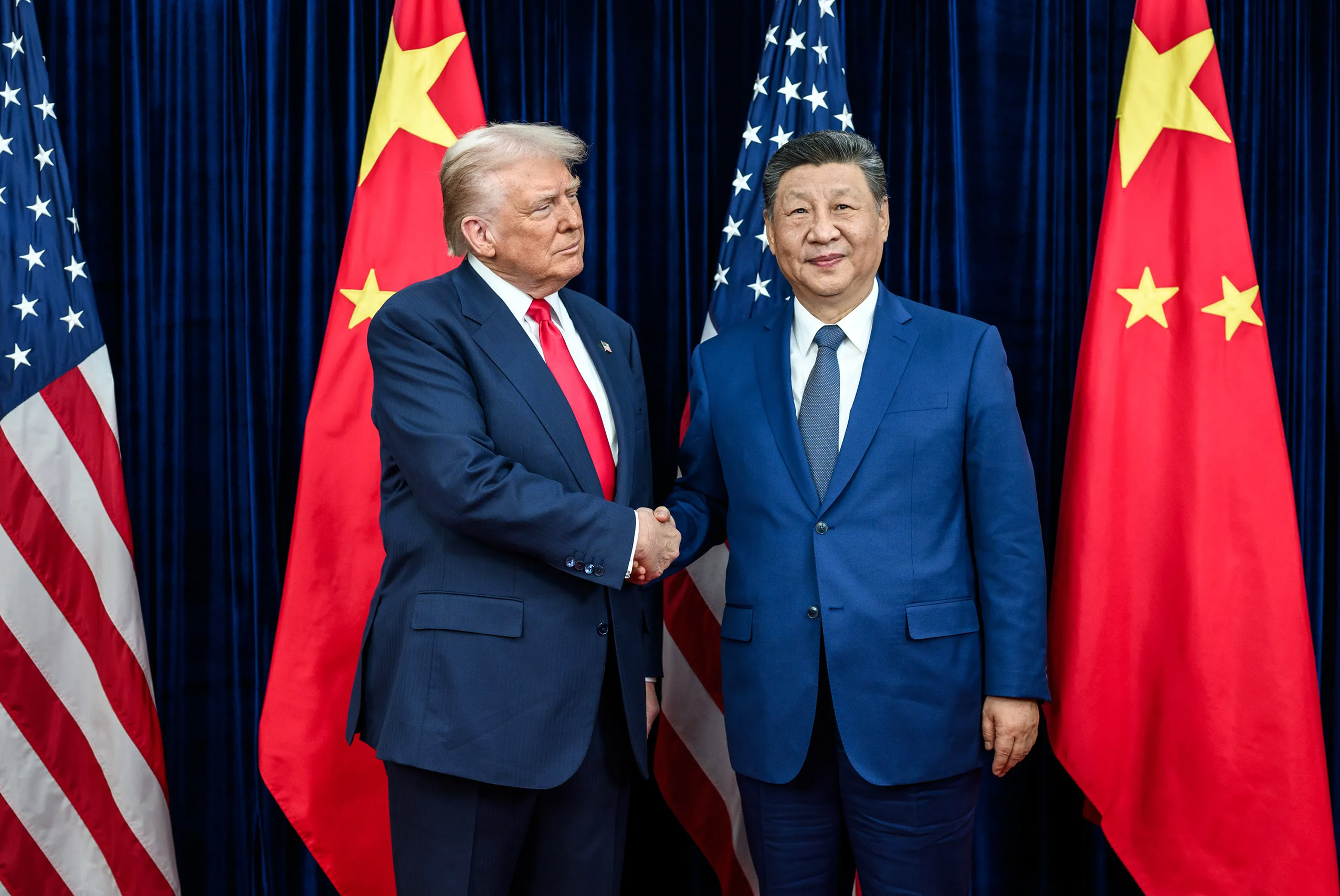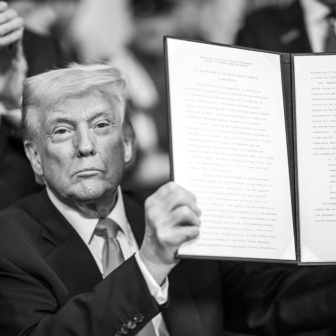In the first Asian tour of his second presidency, Donald Trump attracted higher than ever levels of praise, sycophancy and financial pledges from the region’s leaders. But a social media post might have revealed more about his intentions than the media coverage of those encounters.
Trump’s tour took in the Asia Pacific Economic Cooperation summit in Busan, where South Korea’s president Lee Jae Myung reaffirmed a promise to invest US$350 billion in the United States over the next decade, including in American shipyards, and capped it with a gift of a gold crown, a simulacrum of one worn by an eighth-century Korean monarch.
On his way to Busan, Trump stopped off in Tokyo, where new Japanese prime minister Sanae Takaichi stood by her predecessor’s pledge of US$550 billion investment and added a favourite golf club of her political mentor, the late Shinzo Abe, and a promise of cherry trees and fireworks for next year’s 250th anniversary of US independence. After announcing a planned lift in Japan’s defence spending to 2 per cent of GDP, she even jived with him to “YMCA” aboard a US Navy aircraft carrier.
At the ASEAN summit in Kuala Lumpur, Malaysia’s Anwar Ibrahim let the American president take the credit for the halt in border clashes between Cambodia and Thailand that Anwar himself had largely worked out. So, too, came promises to buy American liquified natural gas, missiles and civilian airliners.
Along with their friendly encounters with Trump, these leaders were rewarded with tariff cuts here and there. Anthony Albanese, meanwhile, capped his Washington visit of a week earlier with a seat next to Trump at a dinner put on by South Korea’s Lee.
Yet there was one meeting where the power dynamics were reversed. There, it started to look like Trump might do what the Australian strategist Hugh White and others have long predicted: give up efforts to maintain paramountcy in the Western Pacific and instead share power with China.
At a ninety-minute meeting with China’s Xi Jinping in Busan it was Trump who appeared the supplicant, heaping praise on the Chinese leader. Xi is “distinguished and respected,” the American president declared; indeed, he is a “great leader of a great country.”
Across the table, Xi showed what US scholar Orville Schell calls the “Mona Lisa–like hint of a smile permanently etched on his face” and duly accepted Trump’s respect. “Given our different national conditions, we do not always see eye to eye with each other, and it is normal for two leading economies of the world to have friction now and then,” said Xi. But the two leaders should “stay the right course and ensure the steady sailing forward of the giant ship of China–US relations… China and the United States should be partners and friends. This is what history has taught us and what reality demands.”
The main tangible outcome of the meeting for Trump was China’s agreement to halt for a year the restrictive conditions it had placed on shipments of seventeen rare-earth elements, including specialised magnets, vital for many kinds of electric vehicles, military aircraft and missiles, mobile phones and medical diagnostic machines. China has near-total control of world trade in these refined materials, and Xi’s use of this high-tech stranglehold has virtually halted Trump’s trade and investment war against China. Shipments of US soybeans, food for China’s pigs, would also resume.
Trump left the APEC meeting early, allowing the enigmatic Xi to project himself and China as a more predictable partner, economically at least. Many diplomatic analysts gave Xi a net win over Trump in courting the Asians.
Asian leaders had come to the summit dreading public humiliations at the hands of an unstable Trump. They were spared that. But after leaving the region, Trump delivered a message that has caused consternation among “China hawks” in American and allied strategic circles, most probably including those in Canberra.
In a social media post, Trump called his “G2 meeting with President Xi of China” a great step for both countries. “This meeting will lead to everlasting peace and success. God bless both China and the USA!” His defence secretary Pete Hegseth also referred to the “G2” in an X post after speaking with Chinese defense minister Dong Jun. Hegseth vowed to “deconflict and de-escalate any problems that arise” between the two militaries.
Hong Kong academic Wang Xiangwei, a former editor of the South China Morning Post, was among those struck by the terminology. “It is this collaborative tease that elevates Busan beyond a photo-op,” he wrote, “hinting at the resurrection of the G2 concept — a bipolar stewardship of global affairs by the world’s two economic titans.”
A G2, or Group of Two, was first postulated by the American economist Fred Bergsten in 2005. He argued that the two major economies — China was already set on a high-growth path — needed to keep talking to work out a modus vivendi.
Some observers have interpreted Bergsten’s argument as a call for China and America to jointly rule the world, with the US dropping the goal of pre-eminence in Asia. “It has come to imply a power equilibrium between the two nations — something that Beijing has long coveted as it ascended from regional powerhouse to pivotal global player,” Didi Tang, a China specialist with the Associated Press, wrote this week. As the Asia Society Policy Institute’s Neil Thomas told her: “The G2 concept implies that China and the United States are peers on the global stage and their positions should be given equal weight.”
Trump’s use of “G2” has stirred unease in Washington and across Asia, wrote Ken Moriyasu this week in Japan’s Nikkei Asia. “Critics from previous administrations argue that the phrase signals a bilateral power arrangement that could alienate America’s allies, especially in China’s neighbourhood.” Mira Rapp-Hooper, Asia adviser to former president Joe Biden, agrees: “It is a term that plays very poorly in countries like Japan, Australia and India,” she told AP’s Tang. “They hear the United States deferring to Chinese preferences in Asia, potentially at a cost to their interest.”
Kurt Campbell, who orchestrated the US “pivot” to Asia under Barack Obama — and, some say, the AUKUS deal under Biden — said there were “real anxieties in Asia about the way the actual G2 was manifested.” It was not just the notion that the countries were making decisions that would affect the region, Campbell told the AP’s Tang. “It was how China used the concept or the idea of it to make other surrounding nations feel insecure.” It was a concept, he said, that “has been powerfully delegitimised.”
Even so, Trump has plucked it from somewhere. His remark came “amid the absence of strategy documents from the Trump administration,” as Nikkei’s Moriyasu noted, “be it on a China strategy, Indo-Pacific strategy or a National Defence Strategy. Trump’s words hint at a new vision of cooperation rather than confrontation with China.”
“Somewhat triumphally,” as Tang noted, Chinese commentary quickly picked up on Trump’s use of the term. “Trump’s G2, to some extent, is that the US has accepted the reality that it no longer has the unipolar position but wants to build a bipolar world with China,” said Housha Yueguang, a popular nationalist blog. “It means Europe is no longer important, let alone Japan or India.”
More circumspectly, a Chinese foreign ministry spokesperson said the two countries “can jointly shoulder our responsibilities as major countries” and “work for an equal and orderly multipolar world.” Zhao Minghao, a Chinese academic specialist on China–US relations, said it “does not mean China and the US co-ruling the world” and nor did it mean that cooperation will replace competition in bilateral relations.
Trump’s remarks suggest he is less interested in dominating the security environment in East Asia than in maintaining ascendancy in high technology and manufacturing. His secretary of state Marco Rubio and defense policy director Elbridge Colby are among those pursuing the longstanding effort to bottle up Chinese military power and contest its diplomatic influence. But other members of his administration are “restrainers” who think the United States should limit its efforts in Asia and Europe and concentrate on the American hemisphere.
The president’s recent show of force towards Venezuela suggests the latter camp has greater sway, and other recent Trump actions have damaged Washington’s attempts to rally a wider array of Asian powers as counterweight to China.
His imposition of 49 per cent tariffs on imports from India — punishment for buying Russian oil — and his susceptibility to Pakistani overtures, has put India’s Narendra Modi in a huff. Modi attended the meeting of the China-sponsored Shanghai Cooperation Agreement, his first China visit in seven years, but stayed away from the ASEAN meeting in Kuala Lumpur. He has apparently refused to take phone calls from Trump.
Vietnam was also hurt by Trump’s high tariffs on its exports, now 20 per cent, as punishment for its role as a finishing-off and rebadging centre for some Chinese exports. It has backed away from buying US military transport aircraft and entered a US$8 billion deal with Russia for advanced fighters and air-defence systems.
For Hong Kong–based commentator Wang, the situation has evolved since Bergsten first mooted the G2 and Washington saw China emerging as a “responsible stakeholder” in the existing world order. Chinese leaders saw that role as a trap, drawing China into burdensome global duties, distracting it from domestic development, and alienating it from the developing world. With later efforts to “contain” China having demonstratively failed, says Wang, a G2 would be one of “co-equals, not patron and junior partner.”
These are early days, Wang cautions, given Trump’s “mercurial” character. “The same feed that praises a G2 today can excoriate China tomorrow,” he wrote. “That volatility partly explains Beijing’s cautious tone. Structural problems also lurk beneath the surface of the relationship: a ballooning US trade deficit with China; enduring US restrictions on high-end chips and tools; data security and platform governance; and, above all, Taiwan.”
Among the likely irritants are the “poison pills” Trump inserted into trade deals with Cambodia, Malaysia and maybe others to prevent them joining supply chains that ultimately benefit China. The clauses “threaten to end the agreements if either country signs a rival pact that jeopardises ‘essential US interests’ or ‘poses a material threat’ to US security, reported the Financial Times.
In a first for a US–China leadership meeting, the two leaders didn’t discuss Taiwan in Busan. “It may be tactical,” Wang ventured, “a decision to avoid blowing up a fragile restart, or it may signal that both sides prefer to manage that issue through quieter channels.”
Next year may see the G2 idea fleshed out. Trump plans a visit to Beijing in April, with Xi making a return visit to Washington later next year. “In the end, even a successful G2 will not be warm all the time,” Wang said. “It will be a volatile tango, marked by recurring bouts of friction and periodic resets. But if Washington and Beijing can institutionalise enough cooperation to stabilise the floor while competing responsibly above it, that alone would be good news — particularly for Asia, where the costs of miscalculation would be immediate and severe.”
While such a shift may not go down that well in the halls of the Australian Strategic Policy Institute, the US Studies Centre at Sydney University and defence agencies, it may not be unwelcome for Albanese. He has just replaced Office of National Intelligence director-general Andrew Shearer — a China hawk appointed by Scott Morrison — with senior career diplomat Kathy Klugman, who is likely to pursue a softer approach to China at the top intelligence coordination and assessment body.
For his part, Hugh White sees his long-predicted power-sharing arrangement coming into being. “Back in the 2010s, when the G2 idea first appeared, there was still an overwhelming assumption in Washington that America’s position of global leadership remained unchallengeable,” White tells me. “Support for the G2 idea was therefore based on the expectation that China was going to be the world’s second-most important and powerful country, but not an equal of the US.”
With everyone else having left the room, says White, Washington imagined America telling China what to do — “not a model that ever appealed to the Chinese, of course.” Trump’s Washington might be realistic: “Behind the MAGA bombast about American greatness and Trumpian power and prowess lies an uneasy recognition that China these days really is an equal, and must be dealt with as such.” •




